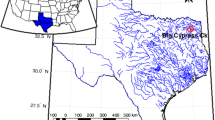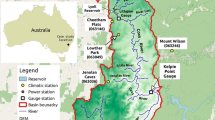Abstract
One of the undeniable requirements in hydrological forecasting and water resources studies is the availability of reliable information. Due to the various reasons, time series data are not usually complete in those surveys, therefore; reconstruction techniques are highly required to complete the missing data. This research was undertaken to evaluate the efficiency of the computer-based methods namely artificial neural network, support vector machine, ARIMA, and ARMAX along with conventional reconstruction strategies of ratio analysis, Fragment, and Thomas-Fiering. As a case study, the monthly flow data of seven hydrometric stations in the Urmia Lake Basin were employed during a 15-year period. The results were then compared using the evaluation criteria of the correlation coefficient (R2), root mean square error (RMSE), standard deviation ratio (SDR), Nash-Sutcliffe efficiency (NSE), and standard error (SE). Based on key results, computerized methods had higher accuracy than conventional ones in data reconstruction. In terms of efficiency, among the computer-based methods, the support vector machine, ARMAX, artificial neural network, and ARIMA model were ranked from the first to fourth in missing data regeneration.








Similar content being viewed by others
References
Adamowski J, Fung Chan H (2011) A wavelet neural network conjunction model for groundwater level forecasting. J Hydrol 407:28–40
Adnan RM, Yuan X, Kisi O, Curtef V (2017) Application of time series models for streamflow forecasting. Civil Environ Res 9(3):56–63
Chao CF, Horng MH (2015) The construction of support vector machine classifier using the firefly algorithm. Comput Intell Neurosci 1:8
Coulibaly P, Evora ND (2007) Comparison of neural network methods for infilling missing daily weather records. J Hydrol 341:27–41
Elganiny MA, Eldwer AE (2013) Comparison of stochastic models in forecasting monthly stream flow in Rivers: a case study of River Nile and its tributaries. J Water Resour Protect 8:143–153
Hamel L (2009) Knowledge discovery with support vector machines. John Wiley, Hoboken, N.J
Hamidi O, Poorolajal J, Sadeghifar M, Abbasi H, Maryanaji Z, Faridi HR, Tapak L (2014) A comparative study of support vector machines and artificial neural networks for predicting precipitation in Iran. Theor Appl Climatol 119:723–731
Kalteh AM (2013) Monthly river flow forecasting using artificial neural network and support vector regression models coupled with wavelet transform. Comput Geosci 54:1–8
Manzour D, Yadi Pour M (2016) Studying the Iranian electricity market price with an ARMAX-GARCH Mode. Quart J Quant Econ 13(1):97–117
Marzi H; Turnbull M; Marzi E (2008) Use of neural networks in forecasting financial market. Soft Computing in Industrial Applications, SMCia '08. IEEE Conference on: 240–245
Memarian H, Balasundram SK (2012) Comparison between multi-layer perceptron and radial basis function networks for sediment load estimation in a tropical watershed. J Water Resour Protect 4:870–876
Rafidah A, Suhaila Y (2013) Modeling river stream flow using support vector machine. Trans Tech Publication 315:602–605
Rojas-Domínguez A, Padierna LC, Carpo Valadez JM, Puga-Soberanes H, Fraire H (2018) Optimal hyper-parameter tuning of SVM classifiers with application to medical diagnosis. IEEE Access 6:7164–7176
Shen L, Chen H, Yu Z, Kang W, Zhang B, Li H (2016) Evolving support vector machines using fruit fly optimization for medical data classification. Knowl-Based Syst 96(15):61–75
Shenify M, Danesh AS, Gocić M, Surya Taher R, Abdul Wahab AW, Gani A, Shamshirband S, Petković D (2016) Precipitation estimation using support vector machine with discrete wavelet transform. Water Resour Manag 30(2):641–652
Silva AT, Portela MM (2012) Disaggregation modelling of monthly stream flows using a new approach of the method of fragments. Hydrol Sci J 57(5):942–955
Solgi A, Nourani V, Pourhaghi A (2014) Forecasting daily precipitation using hybrid model of wavelet-artificial neural network and comparison with adaptive neuro-fuzzy inference system (case study: Verayneh Station, Nahavand). Adv Civil Eng 2014:1–12. https://doi.org/10.1155/2014/279368
Tarekul IGM, Yoshihisa K (2009) Stochastic modeling and prediction of the Ganges flow. Advances in water resources and hydraulic engineering. Springer, Berlin, Heidelberg. https://doi.org/10.1007/978-3-540-89465-0_2
Waseem M, Mani N, Andiego G, Usman M (2017) A review of criteria of fit for hydrological models. Int Res J Eng Technol (IRJET) 4(11):1765–1772
Author information
Authors and Affiliations
Corresponding author
Ethics declarations
Conflict of Interest
None.
Additional information
Publisher’s Note
Springer Nature remains neutral with regard to jurisdictional claims in published maps and institutional affiliations.
Rights and permissions
About this article
Cite this article
Nozari, H., Tavakoli, F. & Mohamadi, M. Comparative Study of Conventional and Computerized Reconstruction Techniques for Flow Time Series Data of Hydrometric Station. Water Resour Manage 33, 1913–1926 (2019). https://doi.org/10.1007/s11269-019-2203-x
Received:
Accepted:
Published:
Issue Date:
DOI: https://doi.org/10.1007/s11269-019-2203-x




